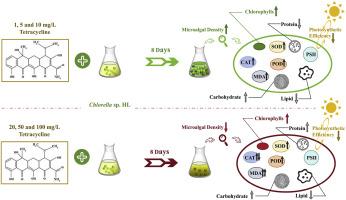Integrated analysis of using high-value microalgae for tetracycline treatment with biomass utilization: Responses, removal pathway, physiological and metabolomic characterization
IF 8.7
Q1 Environmental Science
引用次数: 0
Abstract
Antibiotic-contaminated wastewater poses serious threats to the ecological environment. While using microalgae for antibiotic removal has been extensively studied, this study provides a comprehensive and integrated analysis of the physiological and metabolic response mechanisms of Chlorella sp. HL to tetracycline (TC). The results showed that Chlorella sp. HL exhibited strong TC resistance and high removal efficiencies (98.63–99.95%). Low TC concentrations (<10 mg/L) promoted microalgal growth, while higher concentrations (>20 mg/L) inhibited its growth. Pigment contents (chlorophyll a, chlorophyll b, and carotenoids) generally increased under the stimulation of TC, except for carotenoids at 1 mg/L TC. The photosynthetic activity of Chlorella sp. HL was significantly affected, and it was reduced at higher concentrations of TC. Antioxidant enzyme activities and malondialdehyde (MDA) content increased with TC concentration, indicating TC could cause oxidative stress. In addition, TC altered the high-value substance contents of Chlorella sp. HL, with protein and lipid contents initially declining but subsequently increasing, while polysaccharide content gradually rose. Metabolomic analysis indicated that Chlorella sp. HL responded to TC stress by regulating carbohydrate metabolism and other pathways. This study provides an integrated analysis of the physiological, biochemical, and metabolomic responses of microalgae to TC. This comprehensive analysis provides new insights into how microalgae adapt to and mitigate TC stress, and especially revealing its metabolic response mechanism to TC. In addition, the potential for utilizing microalgal biomass for high-value products production when removing antibiotics has been investigated. This dual focus on bioremediation and resource production is a novel research direction.

生物质利用高价值微藻处理四环素的综合分析:反应、去除途径、生理和代谢组学表征
含抗生素废水对生态环境造成严重威胁。利用微藻去除抗生素已被广泛研究,本研究对小球藻(Chlorella sp. HL)对四环素(tetracycline, TC)的生理代谢反应机制进行了全面、综合的分析。结果表明,小球藻(Chlorella sp. HL)具有较强的抗TC能力和较高的去除率(98.63 ~ 99.95%)。低TC浓度(10 mg/L)促进微藻生长,高浓度(20 mg/L)抑制微藻生长。除类胡萝卜素在1 mg/L TC下显著升高外,其他色素含量(叶绿素a、叶绿素b和类胡萝卜素)在TC刺激下普遍升高。小球藻(Chlorella sp. HL .)的光合活性受到显著影响,高浓度TC降低了小球藻的光合活性。抗氧化酶活性和丙二醛(MDA)含量随TC浓度升高而升高,表明TC可引起氧化应激。此外,TC改变了小球藻高值物质含量,蛋白质和脂肪含量先下降后上升,多糖含量逐渐上升。代谢组学分析表明,小球藻通过调节碳水化合物代谢等途径响应TC胁迫。本研究提供了微藻对TC的生理、生化和代谢组学反应的综合分析。这一综合分析为微藻如何适应和缓解TC胁迫,特别是揭示其对TC的代谢响应机制提供了新的见解。此外,在去除抗生素的情况下,利用微藻生物量生产高价值产品的潜力也得到了研究。这种生物修复和资源生产的双重关注是一个新的研究方向。
本文章由计算机程序翻译,如有差异,请以英文原文为准。
求助全文
约1分钟内获得全文
求助全文
来源期刊

Water Cycle
Engineering-Engineering (miscellaneous)
CiteScore
9.20
自引率
0.00%
发文量
20
审稿时长
45 days
 求助内容:
求助内容: 应助结果提醒方式:
应助结果提醒方式:


